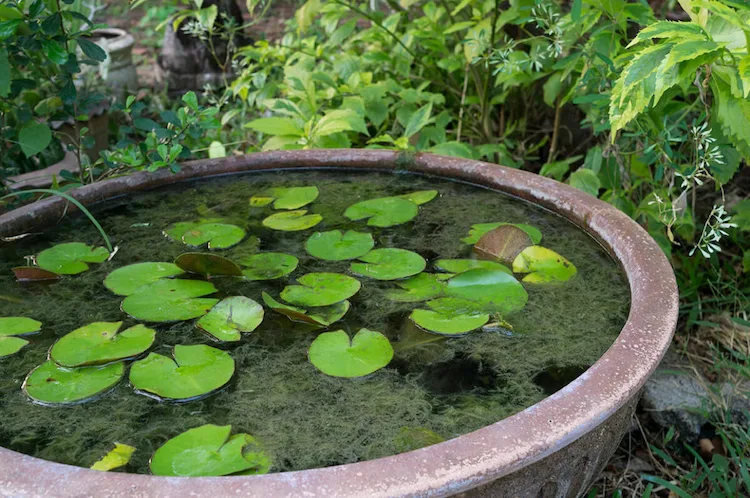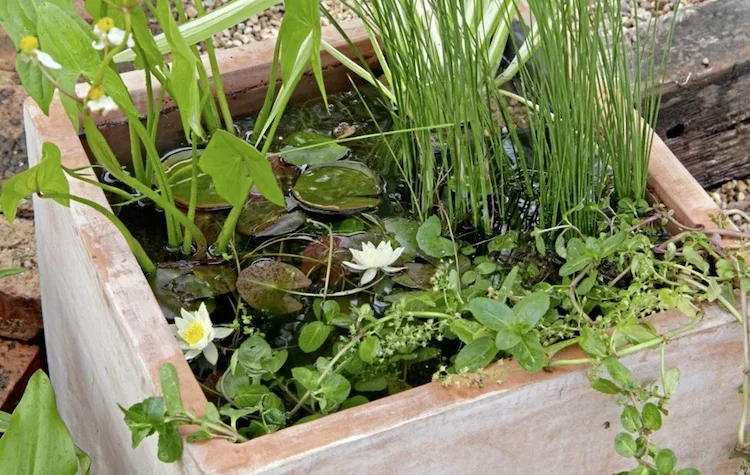Water in the garden is a great idea, not only because it will add freshness and beauty to your outdoor space, but also because water is the key to life for so many creatures. You can easily create a mini pond in the garden to add a touch of individuality. Any pond can become a feeding ground for birds, hedgehogs and bats – the best natural pest controllers in the garden! Your pond doesn’t have to be big. A dishwashing bowl, large flowerpot, or disused sink can be repurposed for this purpose, provided you allow critters to get in and out. Read on, follow our step-by-step guide and enjoy your garden crafting!
Creating a mini pond: what you need
Here are the materials needed for your mini pond.
spade
container
rocks and bricks
Plant
Step-by-step instructions

- First you choose a place. A sunny spot would be good because the pond needs light. Even a mini pond can be dangerous for small children, so place it in a safe place.
- Dig a hole.
- Find or buy a large jar. It should be waterproof, e.g. B. half a barrel, an old water tank or even a large washing-up bowl. It must be able to withstand the rigors of the outdoors, especially the frost. If the vessel is not watertight, e.g. B. an old flower pot, then add a piece of pond liner. Plug all drain holes.
- You can sink the jar into the ground or leave it on the surface, but having the edges level with the ground allows more critters to get in and out.
- For an above-ground pond, you can create a ramp or use bricks, stones, or logs to create stepping stones to get in and out of the pond. Or add a layer of gravel and stones. You can use logs or stones to create different depths and a slope for the animals to climb in and out. If your tank isn’t submerged, you’ll need a ramp from the ground outside the pond. Do not use soil as it will turn your pond green.
- Then fill your pond. Use rainwater as tap water contains chemicals.
- Start planting! It is best to place the plants in special aquatic plant pots. Use very nutrient poor soil. You can buy special pond soil mixed with grit. Always use native plants in ponds. Plant native border plants at the edge of the pond that rise above the waterline to provide perch and cover for wildlife. Be sure to only use plants that won’t get too big for such a small space. Two or three plants is the maximum for a mini pond.
Which plants for your mini pond

Here are some great plants for small ponds:
- Zwergseerose (Nymphaea „Pygmaea Helvola“)
- Small Buttercup (Ranunculus flammula)
- Sternmiere (Callitriche stagnalis)
- Flowering rushes (Butomus umbellatus)
- Also try plants like the water forget-me-not, the lesser buttercup and the marsh marigold.
How is life developing in your pond
For the first few months you don’t need to worry about algae or weeds forming. Have the kids remove the seaweed by wrapping it around a stick – it’s fun! As your mini-pond matures, any pond creatures you have attracted will help keep the water clear. In hot weather you may need to fill up the pond – try using rainwater from a rain barrel.
Don’t be tempted to bring in bucketfuls of pond dwellers from elsewhere. Pond creatures are very good at finding ponds themselves. Toads generally prefer larger ponds, but there’s a good chance a frog or newt will find your mini-pond, especially if you build cover corridors next to the pond and create a frog and toad den nearby.